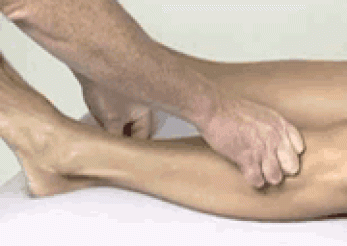Variations on Soft Tissue Release
Types of Strokes
Pin and Stretch is the most basic form of treatment with movement. It has an advantage that it can be done through clothing or a drape. The tissues being stretched are in between the tissue being pinned and the muscle attachment being moved.
Glide and Stretch works along the length of the muscle, loosening adhesions between muscle fibers and between groups of fibers as the muscle is being stretched.
Lifting a muscle while stretching can loosen adhesions between layers of muscles. This can be done with the hands or with massage cups. Lifting can also be used to relieve pressure on nerves. An example is lifting the rectus femoris off of the other quadriceps muscles to take pressure off the femoral nerve.
Broadening strokes can be performed while stretching or contracting a muscle to loosen adhesions that may prevent the normal broadening of a muscle during muscle contraction.
Client Movement
Passive movement works for clients who are tired or who don’t wish to actively engage in their treatment. This is also good for therapists who are codependent and want to help their clients.
Active movement is often more effective than passive movement as it incorporates contraction of the antagonist muscle, which causes inhibition of the muscle being stretched.
Lengthening the muscle while pressure is applied can help separate adhesions between adjacent muscle fibers or bundles of fibers.
Concentric Contraction of the muscle while pressure is applied can have a broadening effect on the muscle fibers, enhancing the natural broadening effect that happens when a muscle contracts. This is often more intense for the client.
Eccentric Contraction of the muscle being worked on may be used to help lengthen a muscle.
Direction of Strokes
Proximal strokes are preferred in muscles with overlying superficial veins, such as the hamstrings and gastrocnemius. Deep pressure should not be used working against the valves of the veins. Proximal strokes are preferred on the plantar fascia if there is pain near the anterior aspect of the calcaneus. The plantar fascia has a narrow attachment there, and distal strokes can pull on that attachment.
Distal strokes can have a lengthening effect on the muscle, and can help to traction joints with impingement problems. Distal strokes may be preferred on the quadriceps for clients with knee pain, as it will reduce stress on the knee and also traction the hip.
Tissue being Worked
Muscle is is the tissue most often worked with Soft Tissue Release techniques.
Ligaments and Retinacula may be worked while they are being stretched or shortened.
Fascia in between muscles may be worked to help unbind adjacent muscle groups. An example is working in between Tibialis Anterior and Peroneus muscles while your client dorsiflexes and plantarflexes their ankle.
Techniques
Many Soft Tissue Release techinques are in the Sports Massage DVD at
https://massagelibrary.com/category/sports-massage-dvd/soft-tissue-release/
Please note that many of the techniques shown in this section are performed quickly. When I originally learned Soft Tissue Release I was taught to do the stretches in under 2 seconds to avoid the stretch reflex. I have found in my practice that the work is more effective and feels better to my client when I go slower.
“Important: The length of time that a stretch is held for has nothing to do with whether the stretch reflex is activated or not. Don’t let anyone tell you that the stretch reflex is not activated because the stretch is only held for one or two seconds. The stretch reflex in the calf muscle for example is triggered within 3 hundredths of a second, so any claim that a particular type of stretching can somehow bypass or outsmart the stretch reflex is nothing more than fantasy.”
From: https://stretchcoach.com/articles/myotatic-stretch-reflex/
Newer techniques are under New Techniques at
https://massagelibrary.com/category/new-techniques/sports-massage/soft-tissue-release-sports-massage/
Quadriceps – Origin to Insertion https://massagelibrary.com/video/quadriceps-6/
Sternnocleidomastoid https://massagelibrary.com/video/sternocleidomastoid/
Dowager’s Hump Techniquehttps://massagelibrary.com/video/dowagers-hump/
Rhomboserratus Rockhttps://massagelibrary.com/video/rhomboids-serratus/
Scalenes – Side Lyinghttps://massagelibrary.com/video/scalenes-pec-major-pec-minor-subscapularis/
Pectoralis Major – Side Lyinghttps://massagelibrary.com/video/scalenes-pec-major-pec-minor-subscapularis/
Pectoralis Minor – Side Lyinghttps://massagelibrary.com/video/scalenes-pec-major-pec-minor-subscapularis/
Subscapularis – Side Lyinghttps://massagelibrary.com/video/scalenes-pec-major-pec-minor-subscapularis/
Tricepshttps://massagelibrary.com/video/triceps-str/
Pronators and Supinatorshttps://massagelibrary.com/video/pronators-and-supinators/
Flexor Retinaculumhttps://massagelibrary.com/video/flexor-retinaculum/
Rectus Femoris – lifting techniquehttps://massagelibrary.com/video/knee-flexion-answer/
Sartorius, Tensor Fascia Latahttps://massagelibrary.com/video/sartorius-tfl/
TFL, Gluteus Maximushttps://massagelibrary.com/video/tfl-and-gluteus-maximus/
IT Band – Cuppinghttps://massagelibrary.com/video/iliotibial-band-side-lying/
Iliacus Release – Supinehttps://massagelibrary.com/video/iliacus-release/
Plantar Fasciahttps://massagelibrary.com/video/plantar-fascia/
Talus Resethttps://massagelibrary.com/video/talus-reset/
https://massagelibrary.com/category/new-techniques/sports-massage/soft-tissue-release-sports-massage/


1 thought on “Soft Tissue Release”
Thank you for this post 🙂 Super Helpful!